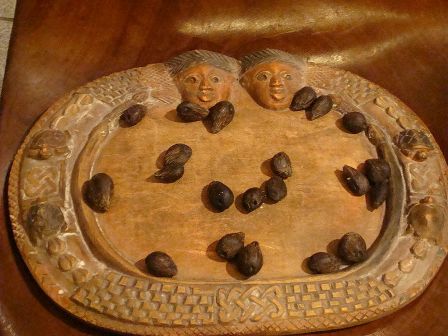by Karen E. Quinones Miller (Osun Lade)
 “Now, we have to find out who’s leading the year.”
“Now, we have to find out who’s leading the year.”
Silence filled the large but crowded room, and all eyes were on the babalawo as he threw the ikin once, then twice, then smoothed his fingers over the palm nuts. He nodded his head, then looked over at his fellow babalawo who nodded his in confirmation.
“Aganju is leading the year,” Baba Ifajoye Ojoawo (Facundo Harris) solemnly proclaimed.
An “ooh,” escaped the lips of some of the priests and alejo sitting in the wooden folding chairs, some furiously scribbling on note pads.
“And now we see who’s backing him,” Baba Ifajoye Oloawo said. He looked over the odus that had already been thrown, then rubbed his chin. “Let’s see if it’s Osun.”
Again he threw the ikin twice, smiled, and looked over his fellow babalawo, Chief Oluwole Ifakunle Adetutu, who again nodded.
“Osun is backing Aganju up,” Baba Ifajoye Ojowao proclaimed.
“Ye ye o,” a female priest in the second row said in response.
It was January 1, 2011, and the occasion was the Reading of the Year, that solemn ceremony done annually in houses throughout the Yoruba community – the time when practitioners gather to see what the upcoming year will be like, and what they need to do to prepare for it.
This particular Reading was being held in the home of Kevin Greene (omo Obatala), who had opened his house to many of the Yoruba in the Philadelphia community. But there were readings being done all over the United States during the opening days of 2011.
“The Reading is a way to get a snapshot of the year,” said Baba Ifajoye Oloawo after the ebos were marked, and the reading was closed. Baba Ifajoye Oloawo, who was initiated into ifa in 2000, has done Readings of the Year in Philadelphia for the past ten years.
“It’s the best way to strategically position ourselves to evade the negative things that the new year will present,” he continued, “and at the same time position ourselves to receive the blessings that present themselves.”
Chief Oluwole Ifakunle Adetutu agrees. “Remember Obara Meji says ‘He who knows does not die like he does not know,’ and that means that the life of a person with knowledge is better than the life of a person without knowledge. The Reading of the Years arms us with information that can save our lives.”
Chief Oluwole Ifakunle Adetutu, who was initiated into ifa in 1989, says that historically the Readings of the Year have given information that may have seemed inconceivable at the time, but which was later borne out.
“For instance,” he points out, “In the Reading of the Year done in Cuba in 1945 it was said that there would be a catastrophe like that which the world had never before known, and there would be a large loss of life.”
It was in July of that same year that the United States dropped atomic bombs in Hiroshima and Nagasaki, killing thousands.
But while most of us see the Reading of the Year as being held to give us knowledge, that is not its only purpose.
“It’s also a ceremony of praise,” adds Lloyd Weaver (Olosunmi) who was initiated Yemanja in 1973, and now lives in Nigeria.
“We use diloggun or Ifa to praise our orisa. In the process we are referring to our scripture — our scripture being diloggun and Ifa – and the orisa refer to us through odu, and collectively our priests recite the odu, and gives the advice that comes from them,” Olosunmi said in a telephone interview from Lagos.
When the reading is done by a babalaowo, the ikin – the sacred palm nuts through which Ifa speaks directly – is used.
When done by an Orisa priest, the Elegba diloggun is used, and each orisa is asked to speak, according to Olosunmi.
“We take an odun from each orisa and read it thoroughly,” Olosunmi explained. “The last orisa read is the orisa of the head of the house or group.”
The followers of a particular Ocha house, Ifa house, or a specific group – such as an egbe – assemble together to have a Reading of the Year done for their particular collective.
“An important purpose of the Reading of the Year is to bring people together who don’t necessarily see each all the time,” Olosumni said. “It forms a commonality as people seek collective guidance. And while we commune together to seek guidance through diloggun or through Ifa, and ask for guidance as a community, generally what comes out applies to each of us as individuals.”
What is remarkable, Baba Ifajoye Oloawo, Chief Oluwole Ifakunle Adetutu and Olosunmi agree, is the consistency between the readings done by one group to another.
In New York, a Reading of the Year was done by a Shango priest on January 2nd and it was again divined that Aganju was leading the year, backed up by Osun.
“One of the things I’m proud of, and is that even in my absence this tradition (the Reading of the Year) has continued,” Olosunmi said solemnly. “I think one of the reasons for the growth of our (Ocha) house as a cohesive unit is we begin each year with a kind of a family reunion: The Reading of the Year.”



